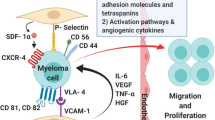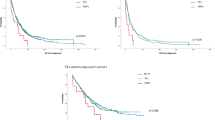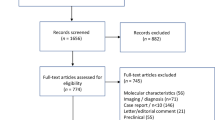Abstract
Extramedullary (EM) plasmacytomas (EMPs) that are not progression of intramedullary (IM) plasma cell myeloma (PCM) are usually indolent. In contrast, EM spread of IM PCM is associated with a poor prognosis. The recently introduced Durie-Salmon PLUS staging system includes EM disease in the poor prognosis category. One study noted an increase in EM disease both at diagnosis and during follow-up of PCM in 2000–2007 compared with previous years raising concerns that adoption of novel agents (thalidomide, lenalidomide and bortezomib) and greater use of hematopoietic cell transplantation (HCT) might be contributory to this. It is uncertain if this is a true increase or merely greater detection due to the increasing use of more sensitive imaging techniques (computerized tomography, magnetic resonance imaging and 18F-fluorodeoxyglucose positron emission tomography) or a reflection of the evolving natural history of PCM in an era when patients are living longer (median overall survival before 1996 was 29.9 months vs 44.8 months after 1996). Recent studies suggest there are important biological differences between PCM with or without EM spread that are offering clues that might explain the propensity for dissemination and a more aggressive clinical course. For example, EM relapse in PCM with and without deletion 13 was 30.8 vs 5.6%, suggesting the biology of a plasma cell subclone before HCT can affect the nature of the relapse after HCT. This article will explore the clinical, biological and treatment implications of EM spread of PCM. In addition, the impact of extramedullary disease on the outcomes of autologous and allogeneic HCT for PCM will be analyzed. Allogeneic HCT early in the course of high-risk PCM with EM disease is a consideration since graft vs myeloma effects may be essential to achieve maximal survival benefits.
This is a preview of subscription content, access via your institution
Access options
Subscribe to this journal
Receive 12 print issues and online access
$259.00 per year
only $21.58 per issue
Buy this article
- Purchase on Springer Link
- Instant access to full article PDF
Prices may be subject to local taxes which are calculated during checkout
Similar content being viewed by others
References
Varettoni M, Corso A, Pica G, Mangiacavalli S, Pascutto C, Lazzarino M . Incidence, presenting features and outcomes of extramedullary disease in multiple myeloma: a longitudinal study on 1003 consecutive patients. Ann Oncol 2010; 21: 325–330.
Kumar SK, Rajkumar SV, Dispenzieri A, Lacy MQ, Hayman SR, Buadi FK et al. Improved survival in multiple myeloma and the impact of lnovel therapies. Blood 2008; 111: 2516–2520.
Durie BG . The role of anatomic and functional staging in myeloma: description of Durie/Salmon Plus staging system. Eur J Cancer 2006; 42: 1539–1543.
Durie BGM, Waxman AD, D’Agnolo A, Williams CM . Whole body F- FDG PET identifies high-risk myeloma. J Nucl Med 2002; 43: 1457–1463.
The International Myeloma Working Group. Criteria for the classification of monoclonal gammopathies, multiple myeloma and related disorders: a report of the International Myeloma Working Group. Br J Haematol 2003; 121: 749–757.
Kyle RA, Gertz MA, Witzig TE, Lust JA, Lacy MQ, Dispenzieri A et al. Review of 1027 patients with newly diagnosed multiple myeloma. Mayo Clin Proc 2003; 78: 21–33.
Alexiou C, Kau RJ, Dietzfelbinger H, Kremer M, Spiess JC, Schratzenstaller B et al. Extramedullary plasmacytoma: tumor recurrence and therapeutic concepts. Cancer 1999; 85: 2305–2314.
Damaj G, Mohty M, Vey N, Dincan E, Bouabdallah R, Faucher C et al. Features of extramedullary and extraosseous multiple myeloma: a report of 19 patients from a single center. Eur J Haematol 2004; 73: 402–406.
Blade J, Lust JA, Kyle RA . Immunoglobulin D multiple myeloma: presenting features, response to therapy, and survival in a series of 53 cases. J Clin Oncol 1994; 12: 2398–2404.
Blade J, Kyle RA, Greipp PR . Presenting features and prognosis in 72 patients with multiple myeloma who were younger than 40 years. Br J Haematol 1996; 93: 345–351.
Wu P, Davies FE, Boyd K, Thomas K, Dines S, Saso RM et al. The impact of extramedullary disease at presentation on the outcome of myeloma. Leuk Lymphoma 2009; 50: 230–235.
Short KD, Rajkumar SV, Larson D, Buadi F, Hayman S, Dispenzieri A et al. Incidence of extramedullary disease in patients with multiple myeloma in the era of novel therapy, and the activity of pomalidomide on extramedullary myeloma. Leukemia 2011; 25: 906–908.
Dimopoulos M, Terpos E, Comenzo RL, Tosi P, Beksac M, Sezer O et al. International myeloma working group consensus statement and guidelines regarding the current role of imaging techniques in the diagnosis and monitoring of multiple myeloma. Leukemia 2009; 23: 1545–1556.
Fassas AB, Muwalla F, Berryman T, Benramdane R, Joseph L, Anaissie E et al. Myeloma of the central nervous system: association with high risk chromosomal abnormalities, plamsablastic morphology and extramedullary manifestations. Br J Haematol 2002; 117: 103–108.
De Larrea CF, Rosinol L, Cibeira MT, Rozman M, Rovira M, Blade J . Extensive soft tissue involvement by plasmablastic myeloma arising from displaced humeral fractures. Eur J Haematol 2010; 85: 448–451.
Dawson MA, Patil S, Spencer A . Extramedullary relapse of multiple myeloma associated with a shift in secretion from intact immunoglobulin to light chains. Haematologica 2007; 92: 143–144.
Alegre A, Granda A, Martinez-Chamorro C, Diaz-Mediavilla J, Martinez R, Garcia-Larana J et al. Different patterns of relapse after autologous peripheral blood stem cell transplantation in multiple myeloma: clinical results of 280 cases from the Spanish Registry. Haematologica 2002; 87: 609–614.
Perez-Shimon JA, Sureda A, Fernandez-Aviles F, Sampol A, Cabrera JR, Caballero D et al. Reduced intensity conditioning allogeneic transplantation is associated with a high incidence of extramedullary relapse in multiple myeloma patients. Leukemia 2006; 20: 542–545.
Zeiser R, Deschler B, Bertz H, Finke J, Engelhardt M . Extramedullary vs medullary relapse after autologous or allogeneic hematopoietic stem cell transplantation (HSCT) in multiple myeloma (MM) and its correlation to clinical outcome. Bone Marrow Transplant 2004; 34: 1057–1065.
Minnema MC, van de Donk NW, Zweegman S, Hegenbart U, Schonland S, Raymakers R et al. Extramedullary relapses after allogeneic non-myeloablative stem cell transplantation in multiple myeloma patients do not negatively affect treatment outcome. Bone Marrow Transplant 2008; 41: 779–784.
Sheth N, Yeung J, Chang H . p53 nuclear accumulation is associated with extramedullary progression of multiple myeloma. Leuk Res 2009; 33: 1357–1360.
Chang H, Yeung J, Qi C, Xu W . Aberrant nuclear p53 protein expression detected by immunohistochemistry is associated with hemizygous p53 deletion and poor survival for multiple myeloma. Br J Haematol 2007; 138: 324–329.
Chang H, Sloan S, Li D, Stewart AK . Multiple myeloma involving central nervous system: high frequency of chromosome 17p 13.1 (p53) deletions. Br J Haematol 2004; 127: 280–284.
Kremer M, Ott G, Nathrath M, Specht K, Strecker K, Alexiou C et al. Primary extramedullary plasmacytoma and multiple myeloma: phenotypic differences revealed by immunohistochemical analysis. J Pathol 2005; 205: 92–101.
Rasmussen T, Kuehl M, Lodahl M, Johnsen HE, Dahl IM . Possible roles for activating RAS mutations in MGUS to MM transition and in the intramedullary to extramedullary transition in some plasma cell tumors. Blood 2005; 105: 317–323.
Stephens PJ, Greenman CD, Fu B, Yang F, Bignell GR, Mudie LJ et al. Massive genomic rearrangement acquired in a single catastrophic event during cancer development. Cell 2011; 144: 27–40.
Hallek M, Bergsagel PL, Anderson KC . Multiple myeloma: increasing evidence for a multistep transformation process. Blood 1998; 91: 3–21.
Magrangeas F, Avet-Loiseau H, Munshi NC, Minvielle S . Chromothripsis identifies a rare and aggressive entity among newly diagnosed multiple myeloma patients. Blood 2011; 118: 675–678.
Pellat-Deceunynck C, Barille S, Puthier D, Rapp MJ, Harrousea JL, Bataille R et al. Adhesion molecules on human myeloma cells: significant changes in expression related to malignancy, tumor spread, and immortalization. Cancer Res 1995; 55: 3647–3653.
Dahl IM, Rasmussen T, Kauric G, Husebekk A . Differential expression of CD56 and CD44 in the evolution of extramedullary myeloma. Br J Haematol 2002; 116: 273–277.
Katz BZ . Adhesion molecules-The lifelines of multiple myeloma cells. Sem Cancer Biol 2010; 20: 186–195.
Oliveira AM, Maria DA, Metzger M, Linardi C, Giorgi RR, Moura F et al. Thalidomide treatment down-regulates SDF-1 alpha and CXCR4 expression in multiple myeloma patients. Leuk Res 2009; 33: 970–973.
Noborio-Hatano K, Kikuchi J, Takatoku M, Shimizu R, Wada T, Ueda M et al. Bortezomib overcomes cell-adhesion mediated drug resistance through down regulation of VLA-4 expression in multiple myeloma. Oncogene 2009; 28: 231–242.
Yata K, Yaccoby S . The SCID-rab model: a novel in vivo system for primary human myeloma demonstrating growth of CD138-expressing malignant cells. Leukemia 2004; 18: 1891–1897.
Hedvat CV, Comenzo RL, Teruya-Fedstein J, Olshen AB, Ely SA, Osman K et al. Insights into extramedullary tumor cell growth revealed by expression profiling of human plasmacytomas and multiple myeloma. Br J Haematol 2003; 122: 728–744.
Rosinol L, Cibeira MT, Blade J, Esteve J, Aymerich M, Rozman M et al. Extramedullary multiple myeloma escapes the effect of thalidomide. Haematologica 2004; 89: 832–836.
Nakazato T, Suzuki K, Mihara A, Sanada Y, Kakimoto T . Refractory plasmablastic type myeloma with multiple extramedullary plasmacytomas and massive myelomatous pleural effusion: remarkable response with a combination of thalidomide and dexamethasone. Intern Med 2009; 48: 1827–1832.
Gonzalez-Porras JR, Gonzalez M, Garcia-Sanz R, San Miguel JF . Thalidomide in combination with cyclophosphamide and dexamethasone (thalcydex) is effective in soft-tissue plasmacytomas. Br J Haematol 2002; 119: 883–884.
Biagi JJ, Prince HM . Thalidomide is effective for extramedullary relapse of multiple myeloma post-allogeneic bone marrow transplantation. Br J Haematol 2001; 115: 484–485.
Mohty M, Stoppa AM, Blaise D, Ismardon D, Gastaut JA, Olive D et al. Differential regulation of dendritic cell function by the immunomodulatory drug thalidomide. J Leukoc Biol 2002; 72: 939–945.
Rosinol L, Cibeira MT, Martinez J, Mateos MV, Oriol A, Terol MJ et al. Thalidomide/dexamethasone vs bortezomib (velcade)/thalidomide/dexamethasone (VTD) vs VBMCP/VBAD/velcade as induction regimens prior to autologous stem cell transplantation (ASCT) in multiple myeloma (MM): results of a phase III PETHEMA/GEM trial. Blood 2009; 114 Abstract 130.
Paubelle E, Coppo P, Garderet L, Azizi L, Bories D, Gorin NC et al. Complete remission with bortezomib on plasmacytomas in an end-stage patient with refractory multiple myeloma who failed all other therapies including hematopoietic stem cell transplantation: possible enhancement of graft-vs-tumor effect. Leukemia 2005; 19: 1702–1704.
Calvo-Villas JM, Alegre A, Calle C, Hernandez MT, Garcia-Sanchez R, Ramirez G . Lenalidomide is effective for extramedullary disease in relapsed or refractory multiple myeloma. Eur J Haematol 2011; 87: 281–284.
Study to determine efficacy and safety of lenalidomide plus low-dose dexamethasone versus melphalan, prednisone, thalidomide in patients with previously untreated multiple myeloma (FIRST). ClinicalTrials.gov NCT00689936.
Durie BG, Harousseau JL, Miguel JS, Blade J, Barlogie B, Anderson K et al. International uniform response criteria for multiple myeloma. Leukemia 2006; 20: 1467–1473.
Zomas A, Stefanoudaki K, Fisfis M, Papadaki J, Mehata J . Graft-versus-myeloma after donor leukocyte infusion: maintenance of marrow remission but extramedullary relapse with plasmacytomas. Bone Marrow Transplant 1998; 21: 1163–1165.
Sun K, Welniak LA, Panoskaltsis-Mortari A, O’Shaughnessy MJ, Liu H, Barao I et al. Inhibition of acute graft-versus-host disease with retention of graft-versus-tumor effects by the proteasome inhibitor bortezomib. Proc Natl Acad Sci USA 2004; 101: 8120–8125.
Terpos E, Rezvani K, Basu S, Milne AE, Rose PE, Scott GL et al. Plasmacytoma relapses in the absence of systemic progression post-high-dose therapy for multiple myeloma. Eur J Haematol 2005; 75: 376–383.
Liu YY, Patwardhan GA, Bhinge K, Gupta V, Gu X, Jazwinski SM . Suppression of glucosylceramide synthase restores p53-dependent apoptosis in mutant p53 cancer cells. Cancer Res 2011; 71: 2276–2285.
Liu YY . Resuscitating wild-type p53 expression by disrupting ceramide glycosylation: a novel approach to target mutant p53 tumors. Cancer Res 2011; 71: 6295–6299.
Author information
Authors and Affiliations
Corresponding author
Ethics declarations
Competing interests
The authors declare no conflict of interest.
Rights and permissions
About this article
Cite this article
Wirk, B., Wingard, J. & Moreb, J. Extramedullary disease in plasma cell myeloma: the iceberg phenomenon. Bone Marrow Transplant 48, 10–18 (2013). https://doi.org/10.1038/bmt.2012.26
Received:
Accepted:
Published:
Issue Date:
DOI: https://doi.org/10.1038/bmt.2012.26
Keywords
This article is cited by
-
Late-stage myeloma invades kidney without significant effect on renal function: findings from 53 autopsies in a single institute
International Journal of Hematology (2019)
-
The possible role of burden of therapy on the risk of myeloma extramedullary spread
Annals of Hematology (2017)
-
Cutaneous localization in multiple myeloma in the context of bortezomib-based treatment: how do myeloma cells escape from the bone marrow to the skin?
International Journal of Hematology (2017)
-
Impact of extramedullary plasmacytomas on outcomes according to treatment approach in newly diagnosed symptomatic multiple myeloma
Annals of Hematology (2015)
-
Lack of survival improvement with novel anti-myeloma agents for patients with multiple myeloma and central nervous system involvement: the Greek Myeloma Study Group experience
Annals of Hematology (2015)



